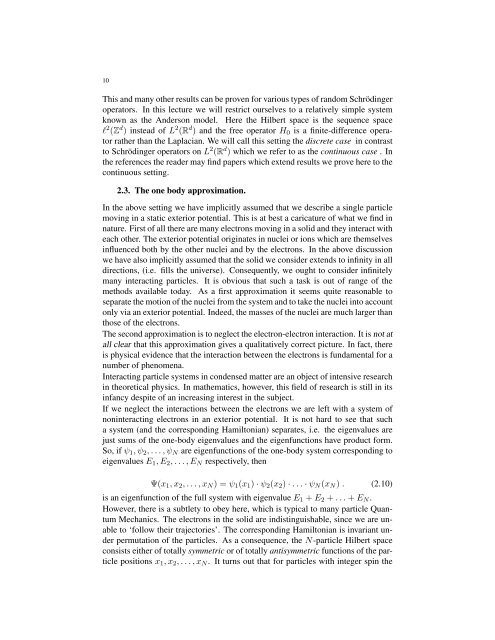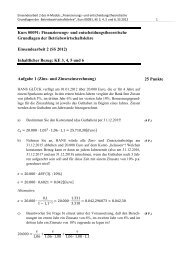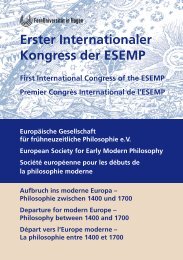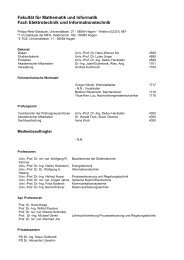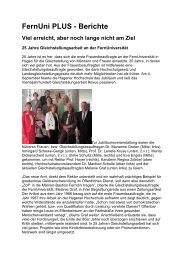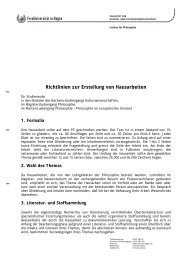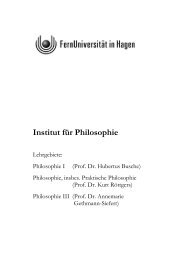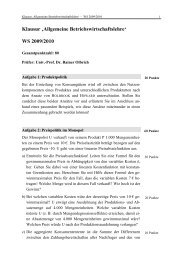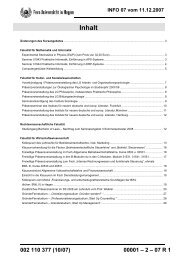An Invitation to Random Schr¨odinger operators - FernUniversität in ...
An Invitation to Random Schr¨odinger operators - FernUniversität in ...
An Invitation to Random Schr¨odinger operators - FernUniversität in ...
Create successful ePaper yourself
Turn your PDF publications into a flip-book with our unique Google optimized e-Paper software.
10<br />
This and many other results can be proven for various types of random Schröd<strong>in</strong>ger<br />
opera<strong>to</strong>rs. In this lecture we will restrict ourselves <strong>to</strong> a relatively simple system<br />
known as the <strong>An</strong>derson model. Here the Hilbert space is the sequence space<br />
l 2 (Z d ) <strong>in</strong>stead of L 2 (R d ) and the free opera<strong>to</strong>r H 0 is a f<strong>in</strong>ite-difference opera<strong>to</strong>r<br />
rather than the Laplacian. We will call this sett<strong>in</strong>g the discrete case <strong>in</strong> contrast<br />
<strong>to</strong> Schröd<strong>in</strong>ger opera<strong>to</strong>rs on L 2 (R d ) which we refer <strong>to</strong> as the cont<strong>in</strong>uous case . In<br />
the references the reader may f<strong>in</strong>d papers which extend results we prove here <strong>to</strong> the<br />
cont<strong>in</strong>uous sett<strong>in</strong>g.<br />
2.3. The one body approximation.<br />
In the above sett<strong>in</strong>g we have implicitly assumed that we describe a s<strong>in</strong>gle particle<br />
mov<strong>in</strong>g <strong>in</strong> a static exterior potential. This is at best a caricature of what we f<strong>in</strong>d <strong>in</strong><br />
nature. First of all there are many electrons mov<strong>in</strong>g <strong>in</strong> a solid and they <strong>in</strong>teract with<br />
each other. The exterior potential orig<strong>in</strong>ates <strong>in</strong> nuclei or ions which are themselves<br />
<strong>in</strong>fluenced both by the other nuclei and by the electrons. In the above discussion<br />
we have also implicitly assumed that the solid we consider extends <strong>to</strong> <strong>in</strong>f<strong>in</strong>ity <strong>in</strong> all<br />
directions, (i.e. fills the universe). Consequently, we ought <strong>to</strong> consider <strong>in</strong>f<strong>in</strong>itely<br />
many <strong>in</strong>teract<strong>in</strong>g particles. It is obvious that such a task is out of range of the<br />
methods available <strong>to</strong>day. As a first approximation it seems quite reasonable <strong>to</strong><br />
separate the motion of the nuclei from the system and <strong>to</strong> take the nuclei <strong>in</strong><strong>to</strong> account<br />
only via an exterior potential. Indeed, the masses of the nuclei are much larger than<br />
those of the electrons.<br />
The second approximation is <strong>to</strong> neglect the electron-electron <strong>in</strong>teraction. It is not at<br />
all clear that this approximation gives a qualitatively correct picture. In fact, there<br />
is physical evidence that the <strong>in</strong>teraction between the electrons is fundamental for a<br />
number of phenomena.<br />
Interact<strong>in</strong>g particle systems <strong>in</strong> condensed matter are an object of <strong>in</strong>tensive research<br />
<strong>in</strong> theoretical physics. In mathematics, however, this field of research is still <strong>in</strong> its<br />
<strong>in</strong>fancy despite of an <strong>in</strong>creas<strong>in</strong>g <strong>in</strong>terest <strong>in</strong> the subject.<br />
If we neglect the <strong>in</strong>teractions between the electrons we are left with a system of<br />
non<strong>in</strong>teract<strong>in</strong>g electrons <strong>in</strong> an exterior potential. It is not hard <strong>to</strong> see that such<br />
a system (and the correspond<strong>in</strong>g Hamil<strong>to</strong>nian) separates, i.e. the eigenvalues are<br />
just sums of the one-body eigenvalues and the eigenfunctions have product form.<br />
So, if ψ 1 , ψ 2 , . . . , ψ N are eigenfunctions of the one-body system correspond<strong>in</strong>g <strong>to</strong><br />
eigenvalues E 1 , E 2 , . . . , E N respectively, then<br />
Ψ(x 1 , x 2 , . . . , x N ) = ψ 1 (x 1 ) · ψ 2 (x 2 ) · . . . · ψ N (x N ) . (2.10)<br />
is an eigenfunction of the full system with eigenvalue E 1 + E 2 + . . . + E N .<br />
However, there is a subtlety <strong>to</strong> obey here, which is typical <strong>to</strong> many particle Quantum<br />
Mechanics. The electrons <strong>in</strong> the solid are <strong>in</strong>dist<strong>in</strong>guishable, s<strong>in</strong>ce we are unable<br />
<strong>to</strong> ‘follow their trajec<strong>to</strong>ries’. The correspond<strong>in</strong>g Hamil<strong>to</strong>nian is <strong>in</strong>variant under<br />
permutation of the particles. As a consequence, the N-particle Hilbert space<br />
consists either of <strong>to</strong>tally symmetric or of <strong>to</strong>tally antisymmetric functions of the particle<br />
positions x 1 , x 2 , . . . , x N . It turns out that for particles with <strong>in</strong>teger sp<strong>in</strong> the


